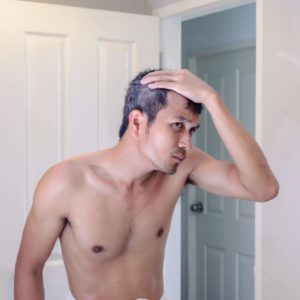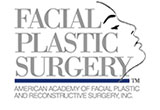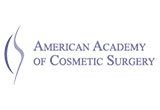Hair Restoration in Manasquan and Toms River, NJ
What Causes Hair Loss?
Hair loss may occur for several reasons, including certain hairstyle and styling products. More common reasons for hair loss include:
- Androgenetic alopecia, also known as hereditary hair loss. Approximately 80 million people in the United States experience this type of hair loss or thinning. Both male and female pattern baldness could be attributed to androgenetic alopecia.
- Nutritional deficiencies. Hair loss may occur as a result of dramatic weight loss. Iron and protein deficiency may also cause hair to fall out.
- Stress and hormones. Some women notice substantial hair loss after giving birth or during perimenopause.
Many of the causes of hair loss that do not relate to genetics correct on their own over time. Hair transplant treatment can address situations in which hair loss has occurred, but follicles are still viable.
Am I a Good Candidate For Hair Restoration?
Patients with male pattern baldness, baldness from accidents, operations, burns, radiation treatment, infection, or even those who have lost their eyebrows are good candidates for this procedure. In some cases, insurance carriers may cover the cost. Patients must realize that the full head of thick hair present before the balding process will not reappear as a result of the procedure. They should also realize that transplanted hair frequently falls out initially, and grows back in two to four months. With proper hairstyle and grooming, a patient can achieve an appearance close to that of full hair growth.
The best approach should be conservative, with the goal being a natural-appearing, adult hairline. Hair transplantation should be approached with the patient’s present and future hairline and overall appearance in mind.
We offer two methods of hair restoration: Neograft Hair Transplantation and PRP.
What Is Hair Transplantation?
Many people experience great anxiety and loss of self-esteem when faced with natural, hereditary hair loss and baldness. Virtually all men, as they age, will experience some degree of hair loss. The extent and pattern of loss depends on the genetic predisposition. Many approaches to hair replenishment are available including hair weaves, wigs, hair pieces, surgery, Minoxidil, Propecia®, and others.
Hair transplant surgery has gained wide popularity amongst the 60 to 70 percent of men and small percentage of women who experience alopecia, the medical term for baldness. Beginning hair transplantation before one is completely bald is an excellent idea, allowing some existing hair to be combed over the new grafts while the patient awaits growth of newly transplanted hair. Serving patients from Toms River, Manasquan, Monmouth County, Ocean County and surrounding areas, Dr. Foster can help restore your hair and help you feel like yourself again.
What Is NeoGraft™?
After much research, we have chosen to offer the Follicular Unit Extraction (FUE) method utilizing the NeoGraft Automated Hair Transplantation device, a much more desirable option because of the vast benefits the less invasive technique offers patients. The FUE method of hair transplantation removes individual hair follicles from the scalp in their naturally occurring groupings of about 1-4 hairs and are then placed in the areas of the scalp where balding has occurred.
Why Use NeoGraft™ Hair Transplantation?
- Least invasive procedure for hair transplantation
- Patients feel little to no discomfort
- No stitches or staples
- Shorter recovery time
- No numbness where the donor hair is harvested
- Less activity restrictions after procedure
- No unsightly linear scar, hair can be worn short
- Patients can typically go back to work the next day
- Transplants roughly twice as many hair grafts as manually FUE
- Cuts the cost of treatment by as much as half as in most cases
- it reduces the need for additional procedures
What Is The Success Rate?
There is technical success in hair transplantation, and there is subjective success. Both are important to us. We want every patient to feel good about the results achieved from their customized treatment plan. To accomplish this, we do our best to discuss the predicted outcome and all other details of the hair transplant process during our initial consultation and planning phase of care. Technical success is as straightforward as observing how many transplanted follicles “take.” Overall, the success rate of treatment is anywhere from 95 to 99 percent successful. The specific technique used by the NeoGraft system, called “coring,” along with gentle suction, significantly improves the viability of harvested hairs.
Is A Hair Transplant Painful?
What is recovery like after a hair transplant:
One of the valuable aspects of the NeoGraft method is that recovery is quick and comfortable. After treatment, the scalp area may feel swollen and sore. If hair transplant treatment has addressed the front hairline or temple areas, swelling and mild bruising may develop on the face, especially around the eyes. This is a typical effect of scalp manipulation that will gradually subside as the tissue heals.In addition to swelling and mild discomfort, patients will notice tiny scabs where hair follicles have been treated. These will crust and fall away over the course of about a week.
Hair Plugs vs Hair Transplant

How Much does a hair transplant cost?
Hair transplant treatment is considered a cosmetic procedure so is not covered by insurance. Understandably, patients want to maximize their investment into new hair growth. This is why we have elected to use the NeoGraft system to support optimal patient outcomes. The cost of hair transplant varies based on factors including the cost per graft and the number of grafts needed. Cost may also be influenced by head size, hair density, medical history, and other factors.The best way to know how much hair transplant treatment may cost is to consult with an experienced provider such as FosterMD.
What is the difference between FUT and FUE?
FUT stands for follicular unit transplantation. This procedure involves the harvesting of strips of tissue from the sides and back of the scalp. Individual follicular units are then extracted from the strips and carefully placed, one by one, into tiny holes the doctor makes in the scalp in the area of thinning or baldness.FUE stands for follicular unit extraction. This technique uses a specialized extraction instrument. In our case, this is connected to the NeoGraft system. After the appropriate number of follicular units have been extracted, they are inserted into the recipient area using a microneedle. The FUE technique is very specific, with follicular units embedded in a particular pattern and angle to achieve the most natural outcome.
What are the Risks of Hair Transplant Surgery?
The NeoGraft technique is one of the most minimally invasive methods of hair restoration. Therefore, the risk of side effects or infection is significantly reduced. In addition to the necessary medication to control comfort, we may also prescribe antibiotics as a preventive strategy.Potential side effects from hair transplant treatment include:
-
- Spot bleeding
- Mild discomfort
- Redness at donor sites
- Itching and thinning
Hair Transplant Before & After

Schedule a Consultation
Starting to notice significant hair loss and looking for a solution? Contact our office at (732) 914-2233 for our Toms River location or (732) 449-2099 for our Manasquan location to schedule a hair transplant consultation today. We serve Monmouth County, Ocean County, and surrounding areas in New Jersey.







